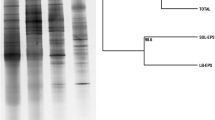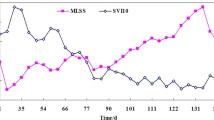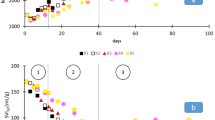Abstract
This study investigated the biodegradability of extracellular polymeric substances (EPS) produced by aerobic granules. Aerobic granules were precultivated with synthetic wastewater in a lab-scale sequencing batch reactor. EPS were extracted from aerobic granules and were then fed as the sole carbon source to their own producers. Results showed that about 50% of EPS produced by aerobic granules could be utilized by their producers under aerobic starvation condition. The average biodegradation rate of the granule EPS in terms of chemical oxygen demand was five times slower than that of acetate, but 50 times faster than that of nonbiodegradable EPS produced by aerobic granules. The nonbiodegradable EPS was mainly found on the outer shell of aerobic granule. EPS produced by aerobic granules basically comprised two major components, i.e., biodegradable and nonbiodegradable EPS. The biodegradable EPS could serve as a useful energy source to sustain the growth of aerobic granules under starvation. This study provides experimental evidence that part of the EPS produced by aerobic granules would be biodegradable, but only nonbiodegradable EPS would play a crucial role in maintaining the structural integrity of aerobic granule.







Similar content being viewed by others
References
APHA (1998) Standard methods for the examination of water and wastewater, 20th edn. American Public Health Association, Washington DC, USA
Boyd A, Chakrabarty AM (1994) Role of alginate lyase in cell detachment of Pseudomonas aeruginosa. Appl Environ Microbiol 60:2355–2359
Danese PN, Pratt LA, Kolter R (2000) Exopolysaccharide production is required for development of Escherichia coli K-12 biofilm architecture. J Bacteriol 182:3593–3596
deBeer D, OFlaharty V, Thaveesri J, Lens P, Verstraete W (1996) Distribution of extracellular polysaccharides and flotation of anaerobic sludge. Appl Microbiol Biotechnol 46:197–201
Dubois M, Gilles KA, Hamilton JK, Rebers PA, Smith F (1956) Colorimetric method for determination of sugar and related substances. Anal Chem 28:350–356
Dudman WF (1977) The role of surface polysaccharides in natural environments. In: Sutherland IW (ed) Surface carbohydrates of the prokaryotic cell. Academic, London, pp 357–414
Flemming HC, Wingender J (2001) Relevance of microbial extracellular polymeric substances (EPSs)—Part I: structural and ecological aspects. Water Sci Technol 43:1–8
Frolund B, Palmgren R, Keiding K, Nielsen PH (1996) Extraction of extracellular polymers from activated sludge using a cation exchange resin. Water Res 30:1749–1758
Liu Y, Tay JH (2004) State of the art of biogranulation technology for wastewater treatment. Biotechnol Adv 22:533–563
Liu YQ, Liu Y, Tay JH (2004) The effects of extracellular polymeric substances on the formation and stability of biogranules. Appl Microbiol Biotechnol 65:143–148
Obayashi AW, Gaudy AF (1973) Aerobic digestion of extracellular microbial polysaccharides. Res J Water Pollut Control Fed 45:1584–1594
Patel JJ, Gerson T (1974) Formation and utilization of carbon reserves by Rhizobium. Arch Microbiol 101:211–220
Pirog TP, Grinberg TA, Malashenko Y, Yu R (1977) Isolation of microorganism—producers of enzymes degrading exopolysaccharides from Acinetobacter sp. Mikrobiologiya 33:550–555
Ruijssenaars HJ, Stingele F, Hartmans S (2000) Biodegradability of food-associated extracellular polysaccharides. Curr Microbiol 40:194–199
Schmidt JE, Ahring BK (1994) Extracellular polymers in granular sludge from different upflow anaerobic sludge blanket (UASB) reactors. Appl Microbiol Biotechnol 42:457–462
Smith P, Krohn R, Hermanson G, Mallia A, Gartner F, Provenzano M, Fujimoto E, Goeke N, Olson B, Klenk D (1985) Measurement of protein using bicinchoninic acid. Anal Biochem 150:76–85
Sutherland IW (1999) Polysaccharases for microbial exopolysaccharides. Carbohydr Polym 38:319–328
Tay JH, Liu QS, Liu Y (2001) The role of cellular polysaccharides in the formation and stability of aerobic granules. Lett Appl Microbiol 33:222–226
Wang Z-W, Liu Y, Tay J-H (2005) Distribution of EPS and cell surface hydrophobicity in aerobic granules. Appl Microbiol Biotechnol 69:469–473
Zhang XQ, Bishop PL (2003) Biodegradability of biofilm extracellular polymeric substances. Chemosphere 50:63–69
Author information
Authors and Affiliations
Corresponding author
Rights and permissions
About this article
Cite this article
Wang, ZW., Liu, Y. & Tay, JH. Biodegradability of extracellular polymeric substances produced by aerobic granules. Appl Microbiol Biotechnol 74, 462–466 (2007). https://doi.org/10.1007/s00253-006-0686-x
Received:
Revised:
Accepted:
Published:
Issue Date:
DOI: https://doi.org/10.1007/s00253-006-0686-x




